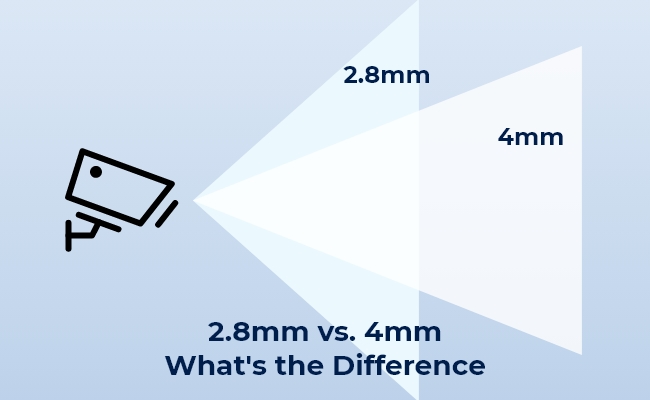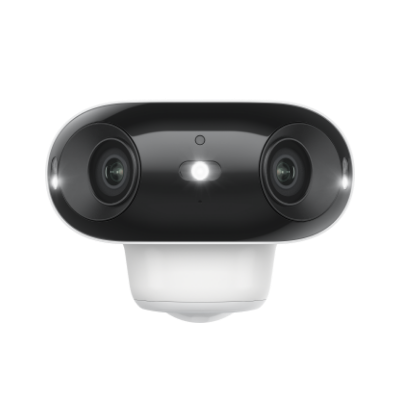2.8mm vs. 4mm: Lens Precision

In the world of photography and videography, the 2.8mm vs 4mm lens debate is at the forefront. When it comes to lens precision, both lenses have their unique strengths and weaknesses. In this article, we will explore more details about the differences between these two lens precisions.
Understanding 2.8mm vs. 4mm Lenses
The measurement (in millimeters) in a security camera refers to the focal length of the lens. This is the distance between the lens and the image sensor when the subject is in focus.
The focal length impacts the angle of view - the amount of the scene that a lens can capture. Now, let's dive deeper into what these measurements mean for each lens.
What is a 2.8mm Lens?
It has a relatively short focal length. This means it provides a wide angle of view, capturing more of the scene in front of the camera. It's equivalent to a wide-angle lens in traditional photography.
The 2.8mm lens is often used when you want to capture a larger field of view, such as landscapes, cityscapes, or large group photos. The wider 2.8mm lens field of view can also be useful in surveillance situations, where covering a large area is more important than detailed close-ups.
What is a 4mm Lens?
On the other hand, a 4mm lens has a longer focal length than the 2.8mm. This results in a narrower field of view. With a 4mm lens, you capture less of the scene, but objects appear closer, and details are more pronounced.
Therefore, this lens is ideal for portraits, close-up shots, or any situation where you want to draw attention to a specific part of the frame. It can also be helpful in surveillance when focusing on a particular area or object.
2.8mm vs. 4mm: What's the Difference?
Several factors highlight their distinctive attributes when comparing 2.8mm and 4mm lenses. The main difference lies in the field of view (FOV): 2.8mm lens offers a wider FOV, making it ideal for capturing expansive landscapes. On the other hand, a 4mm lens has a narrower FOV, which makes it perfect for more focused shots, such as portraits or objects at a moderate distance.
1. Focal Length
The focal length of a lens determines its angle of view and how much of the scene it can capture. A 2.8mm camera lens has a shorter focal length, which can capture a wider scene.
On the contrary, a 4mm lens, with its longer focal length, provides a narrower view, zooming in more on the subject.
2. Field of View
The field of view is directly related to the lens's focal length. A 2.8mm lens field of view is considerably wider, making it ideal for capturing expansive scenes or large groups.
The 2.8mm camera lens angle of view often helps in landscape photography or surveillance systems requiring a broad coverage area. The 4mm lens, with a more restricted field of view, is better suited for focusing on specific subjects or details.
3. Image Clarity
Image clarity can be influenced by the lens used. While both lenses can produce sharp images, a 4mm lens offers better detail resolution because of its narrower field of view than the 2.8 mm lens field of view, making it excellent for portrait photography or any situation where fine detail is paramount.
4. Low-Light Performance
In low-light performance, a lens's capability to gather light becomes crucial. Generally, lenses with shorter focal lengths, like the 2.8mm, tend to perform better in low-light situations due to their wider field of view.
However, the difference might not be significant, and other factors, such as the camera sensor and lens aperture, also play a role.
2.8mm vs. 4mm: Use Cases
When it comes to use cases, both 2.8mm and 4mm lenses have their unique strengths that make them suitable for different scenarios.
General Surveillance
For general surveillance, a 2.8mm lens field of view is wider and is excellent for monitoring large areas such as parking lots or wide open spaces. On the other hand, a 4mm lens, with its narrower perspective, is ideal when detailed observation of specific areas like doorways or narrow corridors is required.
Indoor vs. Outdoor Scenarios
In indoor vs. outdoor scenarios, the choice between these two lenses depends on the coverage area. A 2.8mm lens angle of view is excellent for indoor use where space is limited and a wide view can capture more of the scene.
For outdoor applications where you might want to focus on a particular area or object, a 4mm lens would be more appropriate.
Low-Light Conditions
In low-light conditions, a 2.8mm lens typically performs better due to its wider aperture, allowing more light to reach the camera sensor. However, the performance can also depend on the camera's sensor size and technology.
Advantages of 2.8mm and 4mm Lens
2.8mm and 4mm lenses offer distinct advantages depending on the specific requirements of a photographic or video capture scenario.
Benefits of 4mm Lens
A 4mm lens provides several benefits:
- Detailed Imaging: Its narrower field of view allows for more focused, detailed imaging, which is ideal for portrait photography or surveillance of specific areas.
- Greater Depth of Field: It typically has a greater depth of field, ensuring objects at different distances are in focus.
- Reduced Distortion: This lens usually exhibits less distortion compared to wider angle lenses, providing more realistic images.
- Less Vignetting: A 4mm lens often has less vignetting or darkening around the edges than wider lenses.
- More Control Over Composition: Its narrower field of view allows photographers to control their composition more precisely, focusing on specific elements in the scene.
Benefits of 2.8mm Lens
Conversely, a 2.8mm lens also offers unique advantages:
- Wider Coverage: With its wider field of view, it can cover large areas, making it suitable for landscape photography or general surveillance.
- Better Low-Light Performance: It generally performs better in low-light conditions due to its larger aperture that lets in more light.
- Increased Sense of Depth: A 2.8mm lens can create a more dramatic sense of depth in images, making them appear more three-dimensional.
- Interior Photography: The wide-angle perspective of a 2.8mm lens makes it an excellent choice for interior photography, as it can capture more of the room in a single frame.
- Creative Effects: Wider lenses like the 2.8mm can create unique effects such as exaggerated perspective or greater emphasis on foreground elements.
2.8mm vs. 4mm Security Camera: How to Choose
When selecting a 2.8mm vs 4mm security camera, the choice of lens size is crucial as it significantly influences the camera's field of view and the level of detail in the captured footage. Here are some important factors to consider:
Coverage Area
The first thing to consider is the coverage area. A 2.8mm lens offers a wider field of view and can cover large open spaces effectively. In contrast, a 4mm lens provides a more narrow field of view, focusing on smaller areas but with greater detail.
However, this isn't always true. Take, for instance, Reolink's latest camera, the Argus 4 Pro, which employs two 4mm lenses to achieve a 180-degree field of view, eliminating blind spots. What's more, this security camera features advanced ColorX technology for vibrant full-color night vision.
4k 180° Wire-free Color Night Vision Camera
4K UHD 180° Blindspot-free View; Color Vision Day and Night; 30% More Battery Life; Dual-band Wi-Fi 6; Smart detection.
Distance and Detail
A 4mm lens is a better choice when considering distance and detail if you need to capture finer details from a certain distance, like facial features or license plate numbers. On the other hand, a 2.8mm lens is ideal for closer and broader coverage.
Cost/Budget
Cost/Budget is also an essential factor. While there might not be a significant price difference between 2.8 vs 4mm lens, the cost can vary depending on additional features such as night vision, IR cut filters, or advanced image processing technologies.
For consumers needing full-color night vision without visible spotlights, the Reolink Argus 4 Pro is an excellent choice. Alternatively, those seeking a cost-effective solution that performs well may consider the standard Argus 4 version.
4k 180° Blindspot-free Wi-Fi 6 Camera
4K UHD 180° Blindspot-free View; Dual-band Wi-Fi 6; Smart detection; Easy Installation Anywhere
Compatibility
Lastly, compatibility is crucial. Ensure the chosen lens is compatible with your camera's sensor size and mount type. A mismatch could result in cropped images or vignetting.
Lighting Conditions
Another aspect to consider is the lighting conditions in which the camera will operate. For low-light environments, a lens with a larger aperture, like a 2.8mm lens, would be more suitable as it allows more light onto the camera sensor, leading to brighter and clearer images.
Bonus: 2.8mm vs. 4mm vs. 6mm
To help you further understand the differences between 2.8mm vs 4mm vs 6mm lenses, let's take a look at the comparison table below, which summarizes their key characteristics:
FAQs
What Size Lens is Best for a CCTV Camera?
The best lens size depends on your needs. A 2.8mm lens is great for large areas, while a 4mm or 6mm lens is ideal for focused, detailed surveillance.
Which Lens is Wider, 2.8 mm or 4mm?
A 2.8mm lens is wider than a 4mm lens and covers a larger area due to the different lens specifications, such as focal length and field of view.
How High Should My Security Camera Be?
Typically, security cameras should be mounted 8-10 feet from the ground for optimal coverage and detail.
Conclusion
Choosing between 2.8 mm vs 4mm lenses significantly impacts your CCTV camera's coverage and detail-capturing abilities. A 2.8mm lens offers a wider field of view, ideal for large areas, while a 4mm or 6mm lens provides more detailed surveillance over focused areas.
We encourage you to share your thoughts and experiences about the camera lens selection in the comment section below. Your feedback will be valuable for us!
Search
Subscribe for the Latest Updates
Security insights & offers right into your inbox


